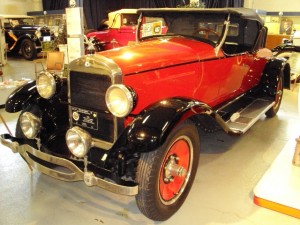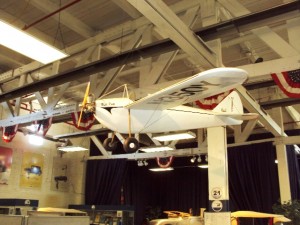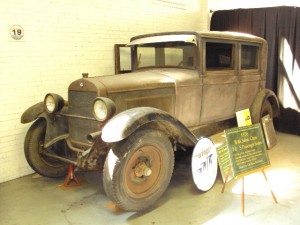Among the more than 5,000 nameplates of automobiles that have come and gone in America over more than a century, one of the lesser known – except to its fans – is that of the Wills Sainte Claire. The make’s symbol on its radiator face as well as its nickname was a grey goose.
The Wills was a luxury car produced from 1921 through 1926 in Marysville, Michigan, on the Sainte Claire River some 50 miles northeast of Detroit. When the brand flopped, like many of the other also-rans unable to sell enough units to make a profit, its founder, C. Harold Wills, was wiped out financially, similar to the fate of William C. (Billy) Durant, the one-time buggy king who “invented” General Motors.
But Durant doesn’t have a museum–unless it is the former GM Building on Detroit’s Grand Boulevard–while the Wills car does. The Wills St. Claire (WSC) Museum, on the southern outskirts of Marysville, huddles modestly among a group of more-or-less modern automotive supplier factories. For example, a Mueller Brass plant is across the street.
The huge factory complex erected in the 1920s by Wills to make his car lies a mile or so to the north, not quite on the banks of the Sainte Claire River separating Michigan from Ontario. Chrysler bought the Wills factory in the mid-1930s to centralize manufacture of boat engines, and a relatively new facility on the same space now is Chrysler Group’s Mopar National Parts Depot.
Inside the WSC Museum, as expected, are displayed a variety of Wills Sainte Claire cars, both restored and, for heightened interest, in “barn-find” condition. There’s also a cutaway of Wills’ aero-derived twin overhead camshaft V8 engine and an un-autopsied OHC straight Six, both well ahead of their time, but expensive to build and maintain.
The 1922 Wills V8 had 265.4 cubic-inch displacement but produced only 67 horsepower—considered pretty good at a time when the Model T Ford’s 167.7-cid Four put out 20 hp. The 273-cid 1926 Wills Six was credited with 65 hp output. To put things further in perspective, the renowned and long-lasting 1932 Ford V8 produced 65 horsepower from 221 cubic inches, later upped to 85 hp. Engines were developing rapidly in that era as Ethyl gasoline allowed higher compression ratios.
The surprise exhibit in the WSC Museum, for my money ($5 admission fee), is a replica of the Buhl Pup single-seat small airplane, of which a reported 100 were built in the former Wills plant in 1930-32. The mid-wing monoplane Pup hangs from the ceiling of the high-bay former factory, and is reminiscent of the Ford Flying Flivver that Ol’ Henry experimented with 1926-28. After the Wills company folded, several other manufacturers of engines and other complex products successively took over the plant, but in the depths of the Great Depression, none “made it” until Chrysler stepped in.
The Wills museum is well laid out, with a successively numbered handout guide to take you through its exhibits. The “poster child” car is a sporty red ‘26 T-6 roadster with a Gotfredson body, owned by museum director and Port Huron businessman Terry Ernest. Gotfredson was a Detroit and Wayne, Michigan and Windsor, Ontario truck and body builder in the 1920s, which supplied bodies for Paige-Detroit cars. A ‘26 T-6 seven-passenger sedan in the museum also has a Gotfredson body.
Other body makers among the museum’s cars are from Budd and Phillips. Indeed, a stripped ’26 T-6 cabriolet on a rotating turntable shows off the aluminum-sheet-over-wood Phillips body construction, another highlight of the museum. Sixes powered all of the 1926 models, whereas the 1922 A-68 Wills had the earlier V8. Another distinction of the ‘22s on display, including a white touring car and a black sedan, is the parking lamp integral with and beneath the headlight, a design feature not carried through to the ‘26s.
In the back shop of the museum were several unrestored barn finds that were donated. Museum volunteers have ranged far and wide to acquire Wills Sainte Claires, of which only 12,107 were built in the few years of the company’s production. Only some 70-80 remain, and the museum has more than ten percent of them on display.
The Wills Sainte Claire Museum has been in operation for about a decade, founded by the brand’s owner club, local historians and enthusiasts. A major event coming up August 13-15, 2010, in Marysville is a national meet of the Wills Club, celebrating the 1959 founding of the museum (before it obtained its present quarters) and Club.
Now, who was C. Harold Wills?
This remarkable figure, born in 1878 who after training in metallurgy and working for some then-small Detroit manufacturers, appeared in 1902 to help Henry Ford develop his experimental 999 race car. When Ford Motor Company was formed the following year, Wills was Henry’s most trusted assistant. Wills designed the famous “script” signature for the Ford company–his most lasting contribution–and also developed Ford’s planetary transmissions and high-strength vanadium steel for frames of early Fords.
By 1919, the two one-time partners had grown cool to one another, but Wills walked away from Ford with $5.6 million (over $70 million in 2010 dollars), partly from the company and partly from his savvy investments in steel companies. With this, he determined to build a new kind of high quality motorcar at what today we would call a “greenfield” plant on 4,200 acres along the Sainte Clair River at Marysville.
He called in planners to lay out an ideal company town near the plant, where stylish houses—many of “kit” construction–were occupied by employees who either bought or rented them at reasonable prices. Alas, the bubble burst with low car sales. Wills later was involved in development of another short-lived luxury car, the Ruxton, but mostly lived well on patent royalties and consulting fees until his death in 1940.
The museum can be found off Michigan Highway M-29 on the south side of Marysville at 2408 Wills Street. From I-94, exit at Gratiot/Business-94 north, turn right on Huron after a couple of blocks, follow Huron east until it intersects with M-29 where you will turn right to follow M-29 south until the industrial district appears on your left as you round a gentle curve toward the river.




Traditional explanations for the (premature) end of the Wills Sainte Claire Automobile company have been that (1) C. H. Wills was a perfectionist, too often tinkering with the car designs and, thus, fatally interfering with production; and (2) production always remained too low to break into overall profit. The first makes little sense to me. How could he have survived 19 years with Ford — being a primary contributor to design of the Model T’s production line — yet stopped his own line on whims? He had good numbers people at WSC, too. Second, other cars that survived well beyond the 20s had even lower production numbers — Peirce Arrow comes to mind.
We do “know” that his (Boston banker-based) financing failed; it is my opinion that his engineering and manufacturing acumen did not. The records may have disappeared of his bank financing but it makes sense to me that all auto companies ultimately must have deep pockets to withstand crises, lean years and threats to management control .
I believe Wills began his WSC dream well before leaving Ford in 1919 and able to count on very deep pockets from private financing. When that failed and he was forced to look (twice) to bankers and “outside” investors who had no patience for the long haul in automotive manufacturing, the future of the company was sealed. It just happened a few years before it had to happen at the crash.
In another universe, where C. H.’s original financing and backers remained viable, he and his car would probably have been absorbed into a giant auto company and survived even into the 21st century. In the end, the survival of any of these autonomous auto companies has been a matter of their financing depth, not their design innovations or manufacturing efficiency. Henry Ford and his company survived because he held control and could fund his company through any crisis. Wills may have recognized that and understood in 1926 that, without backing like that, his dream was over. The line between the success or failure of companies like Ford’s and Wills’s can be traced back to moments when their financing was either cut off or was assured.
I feel we should recognize this as the cause of WSC’s end because companies like his can and do survive their owner’s foibles and bad minor decision-making. Even if Wills tinkered too much and was guided too often by whims, he listened to subordinates and hired good, independent thinkers to advise him. He was rational and imaginative. Over time, one can easily imagine the company surviving and prospering, as he found the right balances between his urges to improve the products and the need to seal in profits through efficient production. Those were not impossible problems for a man with the decades of relevant experience and the abilities of C. H. Wills.
RWN